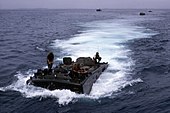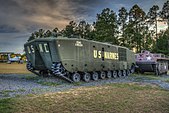This article has multiple issues. Please help improve it or discuss these issues on the talk page. (Learn how and when to remove these messages)
|
| LVTP-5 | |
|---|---|
 An LVTP-5 on display at the USS Alabama (BB-60) memorial in Mobile, Alabama. The front of the vehicle is facing right in this picture. An LVTP-5 on display at the USS Alabama (BB-60) memorial in Mobile, Alabama. The front of the vehicle is facing right in this picture. | |
| Type | Armored personnel carrier |
| Place of origin | United States |
| Service history | |
| In service | 1956–present |
| Used by | See Operators |
| Wars | Vietnam War 1989 Philippine coup attempt |
| Specifications | |
| Mass | 37.4 t |
| Length | 9.04 m (29 ft 8 in) |
| Width | 3.57 m (11 ft 9 in) |
| Height | 2.92 m (9 ft 7 in) |
| Crew | 3+34 passengers |
| Armor | 6-16 mm |
| Main armament | .30 caliber MG/105mm howitzer(LVTP-6) |
| Engine | Continental LV-1790-1 V-12 gasoline 704 hp (525 kW) |
| Power/weight | 19 hp/tonne |
| Suspension | Torsilastic |
| Operational range | 306 km (190 mi) road, 92 km (57 mi) water |
| Maximum speed | 48 km/h (30 mph), in water 11 km/h (6.8 mph) |
The LVTP-5 (landing vehicle, tracked, personnel 5) is a family of amphibious armored fighting vehicles used by the Philippine Marine Corps, the Republic of China Marine Corps, and, formerly, the United States Marine Corps. It was designed by the BorgWarner company and built by FMC (Food Machinery Corporation) along with a few other companies. It was first accepted into service in 1956. Some 1,124 basic units were produced, plus the specialist variants, and many saw action in the Vietnam War.
History
The LVTP-5 was an evolution of the LVT-1 to LVT-4 World War II-era landing vehicle tracked series, but was considerably larger and could carry 30-34 combat-armed troops. A smaller design based on the M59 APC was also produced as the LVT-6, but only a few were built.
The LVTP-5 was replaced in service by the LVT-7 family.
The most common type was the LVTP-5, an armored personnel carrier, with mine-sweeper, command, recovery and fire support variants, the latter mounted a 105 mm howitzer. An anti-aircraft version was prototyped, but never saw service.
As of the mid-2010s, the sole remaining state user of the LVTH-6 was the Philippines, who used four of them for their naval infantry force. As of 2013, Philippine LVTH-6s came in a "digital"-style camouflage pattern.
Variants
- LVTP-5 (landing vehicle tracked, personnel) - armored personnel carrier
- LVTC-5 (landing vehicle, tracked, command) - command vehicle
- LVTH-6 (landing vehicle, tracked, howitzer) - fire support variant armed with M49 105 mm howitzer. Two hundred and ten units built.
- LVTR-1 (landing vehicle, tracked, recovery) - recovery vehicle. Sixty-five units built.
- LVTE-1 (landing vehicle, tracked, engineer) - mine-sweeper. Forty-one units built.
- LVTAA-X1 (landing vehicle, tracked, anti aircraft) - anti-aircraft variant, to be fitted with the turret of the M42 Duster. Only prototype built.
Operators




- Current
 Taiwan
Taiwan
 Republic of China Marine Corps – 150 LVTP-5A1 in service as of 2023.
Republic of China Marine Corps – 150 LVTP-5A1 in service as of 2023.
- Former
 Chile
Chile Philippines
Philippines
 Philippine Marine Corps – 50 purchased in 1975. Four remaining LVTH-6 were decommissioned and delisted from inventory in 2019.
Philippine Marine Corps – 50 purchased in 1975. Four remaining LVTH-6 were decommissioned and delisted from inventory in 2019.
 United States
United States South Vietnam
South Vietnam
Vehicle on Display
Philippines
- LVTP-5
- LVTP-5 Vehicle retired and is on Display at Military Park Luuk, Sulu.
- LVTH-6
- LVTH-6 Vehicle retired and is on Display at Camp Bojeador, Burgos, Ilocos Norte, Philippines.
- LVTH-6 Vehicle retired and is on Display at Naval Station Jose Andrada, City of Manila
- LVTH-6 Vehicle retired and is on Display at Armed Forces of the Philippines Veterans Center. Camp Aguinaldo, Quezon City, National Capital Region.
- LVTH-6 Vehicle retired and is on Display at Philippine Navy Museum, Fort San Felipe, Cavite City, Cavite, Philippines
- LVTE-1
- LVTE-1 Vehicle retired and is on Display at Camp Bojeador, Burgos, Ilocos Norte, Philippines.
Taiwan
- LVTH-6
- LVTH-6 in the Museum of Republic of China Marine Corps.
United States Of America
- LVTP-5
- LVTP-5 United States Marine Corp is on display at Georgia Veterans State Park.
- LVTP-5 on display at the USS Alabama (BB-60) memorial in Mobile, Alabama.
- LVTH-6
- LVTH-6 United States Marine Corps is on display at Mott’s Military Museum in Groveport, Ohio.
See also
References
- ^ "LVTP-5 (1956)". Tanks Encyclopedia. 2016. Archived from the original on 2017-08-02.
{{cite web}}: CS1 maint: bot: original URL status unknown (link) - "Philippine Marine Corps". www.globalsecurity.org.
- IISS (2023). The Military Balance 2023. International Institute for Strategic Studies. p. 293.
- IISS (2023). The Military Balance 2023. International Institute for Strategic Studies. p. 285.
- https://apps.dtic.mil/sti/tr/pdf/ADA361312.pdf
- Dunham, George R (1990). U.S. Marines in Vietnam: The Bitter End, 1973–1975 (Marine Corps Vietnam Operational Historical Series). History and Museums Division Headquarters, U.S. Marine Corps. pp. 19–20. ISBN 9780160264559.
- https://www.marinecorps.mil.ph/citemar6/pdf/citemar6-birthday-issue-2022.pdf
- ^ Mugas, John Michael (2023-01-23). "Philippine Marine Corps eyes putting up detachment unit in Laoag City". INQUIRER.net. Retrieved 2024-04-09.
- Landing Vehicle Tracked (LVT) Naval Station Jose Andrada -Manila, 2017-05-28, retrieved 2024-04-09
Further reading
- David Koller, LVTP5 Landing Vehicle Tracked Personnel 5, 2016, Highgloss Publishing, ISBN 9783033052598.
- SNL G277
- Steven Zaloga, Terry Hadler, Michael Badrocke - Amtracs: US Amphibious Assault Vehicles, 1999, Osprey Publishing (New Vanguard 30), ISBN 1-85532-850-X.
External links
This United States Marine Corps article is a stub. You can help Misplaced Pages by expanding it. |